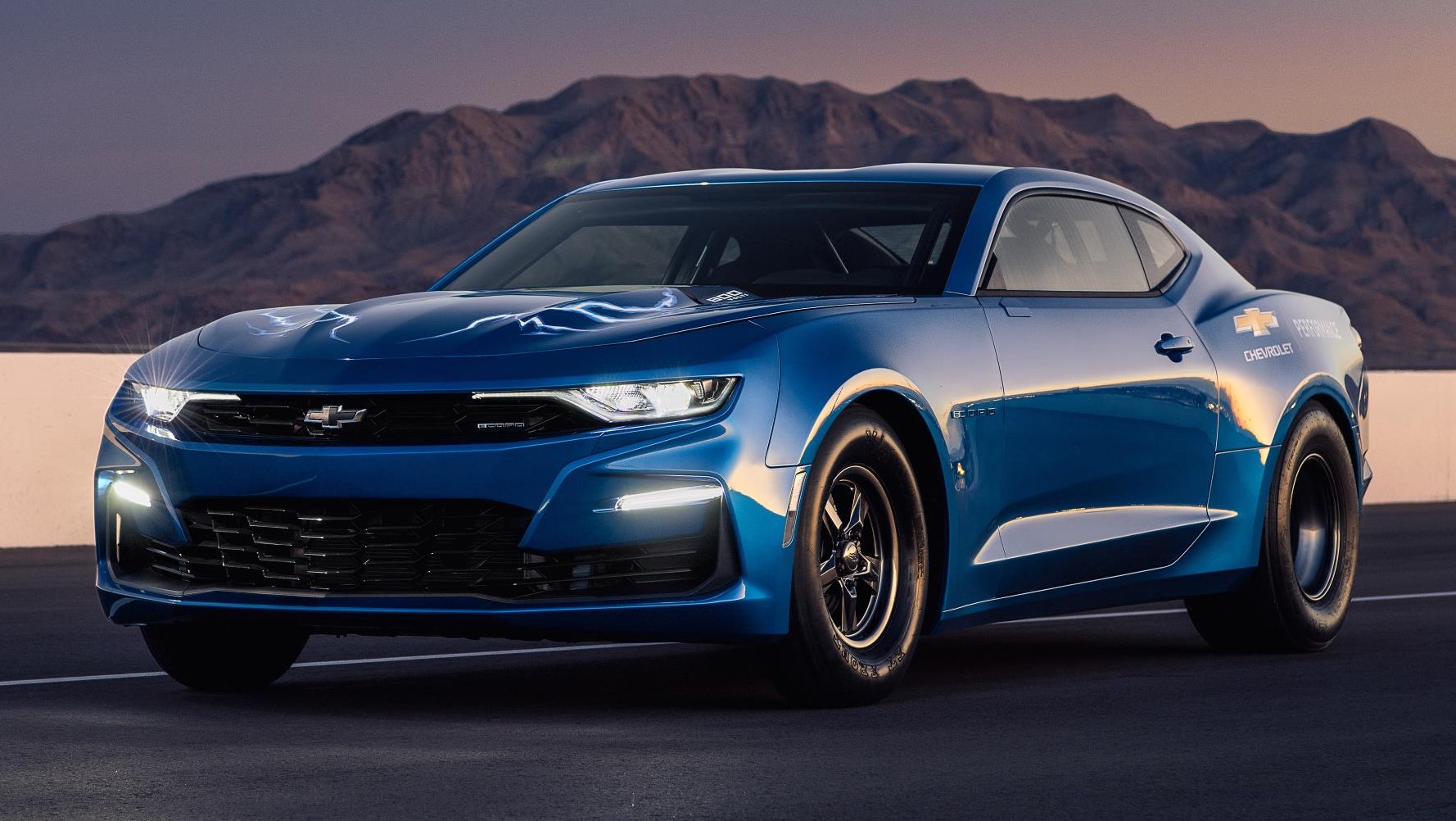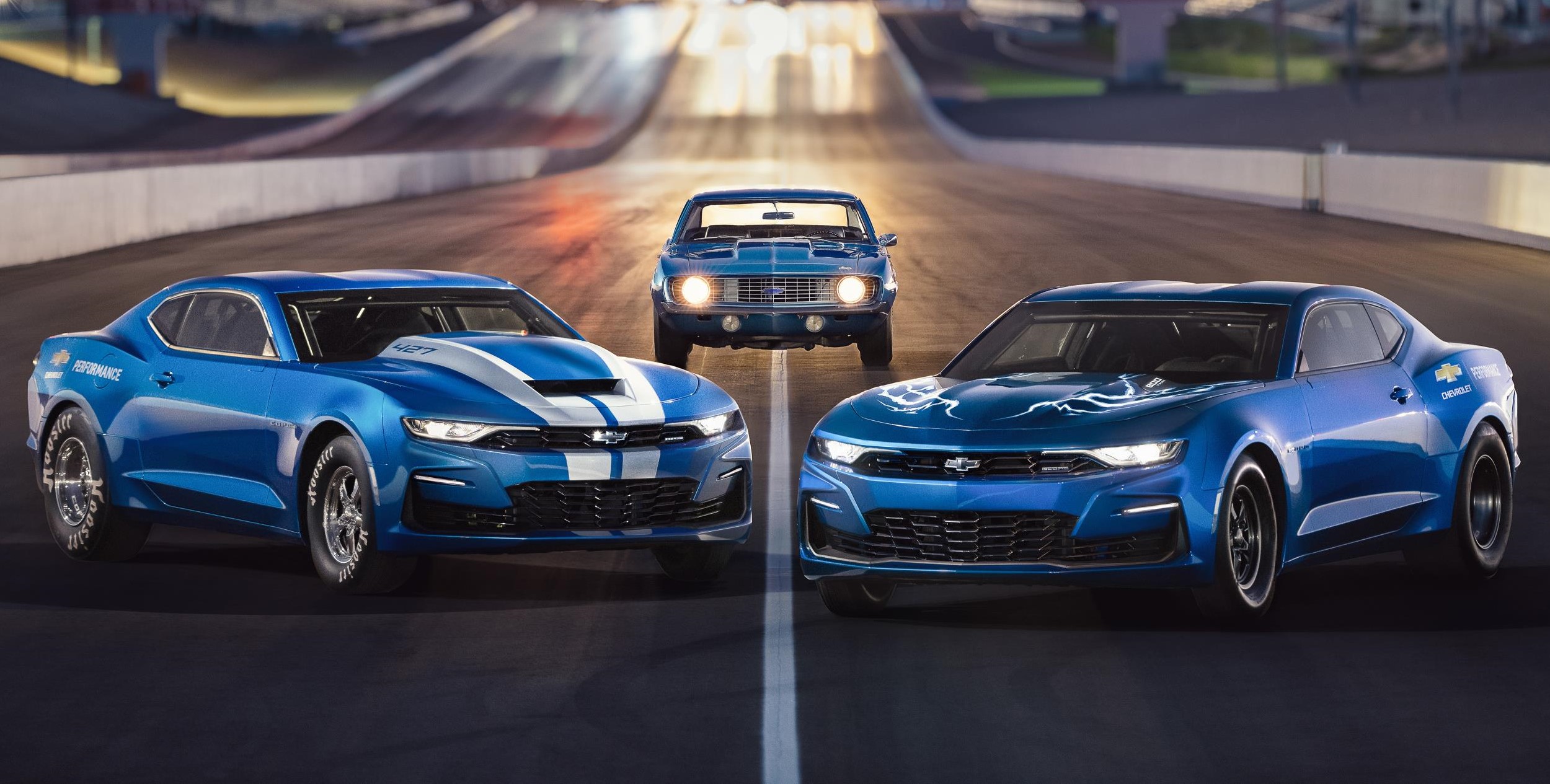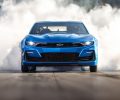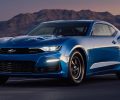
LAS VEGAS — Fifty years after the original COPO Camaro special order performance models were introduced, Chevrolet’s eCOPO Camaro Concept demonstrates an electrified vision for drag racing.
Developed by General Motors and built in partnership with the pioneering electric drag racing team Hancock and Lane Racing, the concept race car — based on the 2019 COPO Camaro — is entirely electric powered, driven by an electric motor providing the equivalent of more than 700 horsepower and 600 lb-ft of torque.
Chevrolet estimates quarter-mile times in the 9-second range. Testing is ongoing.
“The eCOPO Concept is all about where we go in the future with electrification in the high performance space,” said Russ O’Blenes, director, Performance Variants, Parts and Motorsports at General Motors. “The original COPO Camaro program was all about pushing the envelope, and this concept is an exploration with the very same spirit.”
Chevrolet partnered with Hancock and Lane Racing not only because of the team’s success in NHRA drag racing, but also its involvement with Patrick McCue, the driving force behind the record-holding “Shock and Awe” electric drag racing car, and his Seattle-area Bothell High School automotive technology program. With the racing team’s assistance, more than a dozen students participated in the development and assembly of the electrified drag car.
“This project exemplifies Chevrolet and General Motors’ commitment to engaging young minds in STEM education,” said O’Blenes. “It also represents our goal of a world with zero emissions, with the next generation of engineers and scientists who will help us get there.”
800 volts
Just as the original 1969 COPO Camaro models relied on creative engineering to make them successful in Stock Eliminator drag racing, the eCOPO breaks new ground with its unique motor and GM’s first 800-volt battery back.
The electric motor is based on a pair of BorgWarner HVH 250-150 motor assemblies, each generating 300 lb-ft of torque, and replaces the gas engine. It is connected to a conventional racing-prepared “Turbo 400” automatic transmission that channels the motor’s torque to the same solid rear axle used in the production COPO Camaro race cars.
The all-new 800-volt battery pack enables a more efficient power transfer to the electric motor and supports faster recharging, which is important for the limited time between elimination rounds in drag racing.
“Eight hundred volts is more than twice the voltage of the battery packs in the production Chevrolet Volt and Bolt EV, so the eCOPO pushes into new technological territory,” says O’Blenes. “As GM advances its electrification leadership, a big step might just come from the drag strip.”
The battery pack is composed of four 200-volt modules, each weighing approximately 175 pounds, mounted strategically in the car for optimal weight distribution. Two are located in the rear seat area and the other two are in the trunk: one in the spare tire well and the other in the area over the rear axle.
A full Battery Management System monitors all critical voltages and temperatures within the pack. It ties into a comprehensive safety system that continuously evaluates all vehicle electrical components for proper function and safe operation. The batteries in the rear compartment are sealed off from the interior and an integrated driveshaft tunnel has been added between the modules for increased protection. Additionally, the roll cage in the trunk area has been expanded to provide additional protection for the rear-mounted modules.
With the modules’ strategic positions, the eCOPO Camaro has greater than a 56 percent rear-weight bias, which helps launch the car more efficiently.
Electric crate motors
The eCOPO Camaro Concept expands Chevrolet and General Motors’ electrification development and supports future product development. It also suggests a potential new avenue for Chevrolet’s crate engine and performance parts portfolio.
The eCOPO Camaro’s electric motor has the same bell house mounting pattern and crankshaft flange as the popular LS-family engines in Chevrolet’s crate engine portfolio. That allows it to bolt up to just about any General Motors transmission. In fact, the transmission, driveshaft and other drivetrain components remain in the same locations as in a gasoline-powered COPO Camaro race car, meaning the electric motor simply bolts into the engine compartment in place of the gas engine.
“The possibilities are intriguing and suggest a whole new world for racers,” said O’Blenes. “Chevrolet pioneered the concept of the high-performance crate engine right around the time the original COPO Camaro models were created, and the eCOPO project points to a future that could include electric crate motors for racing, or even your street rod. We’re not there yet, but it’s something we’re exploring.”
In the meantime, Chevrolet and Hancock and Lane Racing will continue to develop the eCOPO Camaro and test it on the drag strip, seeking quicker elapsed times with all-new technology.
The eCOPO Concept, shown in Electric Blue, joins the 50th anniversary 2019 COPO Camaro production race car and approximately two dozen additional Chevrolet concepts and show vehicles at the SEMA Show in Las Vegas through Nov. 2.

2019 COPO CAMARO MARKS 50 YEARS OF SPECIAL ORDER PERFORMANCE
LAS VEGAS — An anniversary-themed 2019 COPO Camaro race car introduced today at the SEMA Show celebrates the 50-year milestone of the special order, ultimate performance models and launches the 2019 COPO Camaro program.
“Chevrolet is proud to celebrate 50 years of the COPO Camaro legacy,” said Jim Campbell, GM U.S. vice president of Performance Vehicles and Motorsports. “It’s one of the most enduring legacies in drag racing, with a powerful past and fast future.”
Featuring a special Anniversary Blue Metallic exterior color that pays homage to the original Laguna Blue offered in 1969, the SEMA show car previews the special color and graphics of the COPO Camaro 50th Anniversary Special Edition package offered for 2019. A 50th Anniversary Engine Appearance Package that emulates the look of vintage Chevy performance engines, with an orange engine block, chrome valve covers and a black high-rise intake manifold,
is also available for the naturally aspirated LSX-based 427 racing engine.
The 2019 COPO Camaro’s available engine lineup includes a revised version of the supercharged, LSX-based 350 engine, now featuring a 2.65L Magnuson supercharger as well as a 302-cubic-inch engine. The COPO Camaro also features a distinctive and exclusive front-end design not shared with other production Camaro models.
Only 69 2019 COPO Camaro race cars will be built — the same number of 1969 COPO Camaro models built with the all-aluminum 427 ZL1 engine.
Customers can register for a chance to purchase a 2019 COPO Camaro at www.chevrolet.com/performance/copo-camaro.
COPO Camaro history
The COPO Camaro program got its start in 1969 and was inspired by Illinois-based Chevrolet dealer Fred Gibb, who used the company’s special order system to build what wasn’t already offered in the Camaro. The goal was to make the car more competitive in Stock Eliminator drag racing, which was rooted in production-based vehicles.
Racers scraped for every extra horsepower the factory could give them, and it occurred to Gibb that Chevrolet’s in-house special order system, known as Central Office Production Order (COPO), could provide an advantage. Typically, the COPO system was used for fleet vehicle services such as special paint or truck equipment, but Gibb used it to equip the Camaro with the all-aluminum ZL1 427 racing engine.
With its lightweight block and heads, the ZL1 427 engine weighed about 100 pounds less than the iron-based 396 Big Block engine offered in the Camaro and produced more power. It was the perfect solution for the drag strip.
Chevrolet didn’t simply rubber-stamp Gibb’s request. It took plenty of convincing and some cajoling from Vince Piggins, who was responsible for the Camaro Z28 at the time, to get the project approved. There was also another catch: To make the engine eligible for NHRA competition, at least 50 examples of the car had to be offered for sale to the public.
Gibb ordered them, but knew he’d have a hard time selling the pricey muscle cars, which were essentially twice the cost of a standard Camaro. He sold 13 and the remaining 37 were redistributed to other dealers. In the meantime, more dealers found out about the ultimate performance COPO Camaro models and ordered their own. When the clutch dust settled, 69 COPO Camaro models with the ZL1 engine were built.
The 1969 COPO Camaro program included a number of models equipped with an iron-block version of the 427 engine. In the years after, drag strip success evolved into collector car distinction, with the comparative handful of ZL1-engined models among the most coveted muscle cars with collectors today.
Chevrolet opened the next chapter in the COPO Camaro anthology in 2011 with the introduction of a COPO Camaro race car concept at the SEMA Show. The overwhelming response helped Chevrolet make the decision to build the new COPO Camaro race cars in 2012.
The contemporary COPO cars quickly picked up what their predecessors laid down on the drag strip half a century earlier, setting national records with 8-second elapsed times.
The 2019 COPO Camaro joins the eCOPO Camaro Concept — an electrified race car based on the 2019 COPO Camaro — and approximately two dozen additional Chevrolet concepts and show vehicles at the SEMA Show in Las Vegas through Nov. 2.







